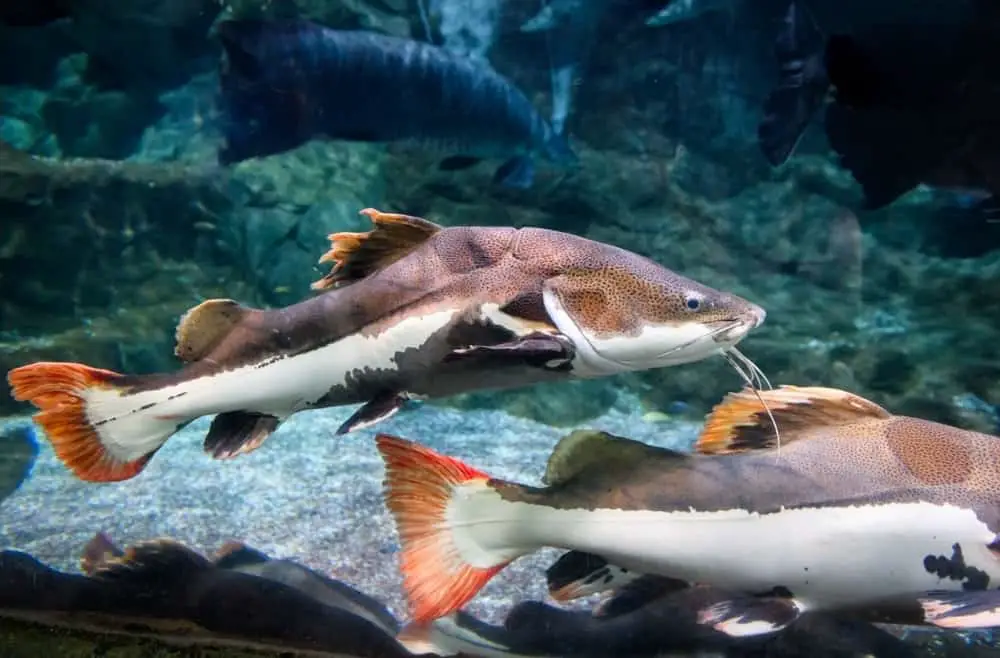Redtail Catfish are a very large species of freshwater fish. They have attractive coloring and distinctive whiskers, making them enticing to beginners when sold in pet shops, despite only being suitable for more experienced aquarists.
If you are trying to figure out whether you could look after a Redtail Catfish, or you just want to learn more about this interesting species, then look no further! We will take you through everything you need to know – size, tank requirements, behaviour, diet and more.

Species Summary
Redtail Catfish are native to South America, found in countries such as Brazil, Peru, Colombia, Venezuela, Ecuador, Guyana and Bolivia. They live in streams, and the basins of River Amazon and the River Orinoco.
They are confident predators who will attempt to eat anything smaller than them, giving them an aggressive reputation. They grow so large in the wild that, when caught, they will feed several large families in one sitting.
Care Guide
Tank Size
To comfortably house this fish you will need a minimum tank size of 1500 to 2000 gallons. Any less and they will be cramped and unhappy- these are large fish that need plenty of space to swim.
Tank Mates
Redtail Catfish are natural predators and will eat any fish smaller than them. Most fish suitable for a freshwater aquarium are smaller than Redtail Catfish, making it difficult to find suitable tankmates for them.
They can live peacefully among non-aggressive fish of a similar size or bigger, but adding more big fish will require increasing the size of your tank, which would already be quite large to house the Redtail Catfish.
Redtail Catfish don’t really need company, so it is easier to keep them in a tank on their own. If you are intending on giving them a tank mate, you could try a sting-ray or a datnoid. They will need to be introduced while they are all at a young age.
Same Species Tanks
You can have more than one Redtail Catfish in one tank, but as they don’t need the company it’s easier for them to be in a tank on their own. They will need to be the same age so they are the same size to avoid them trying to eat each other, and even so they may become territorial and aggressive.
Whilst Redtail Catfish are unlikely to breed in a domestic environment, there are no features to distinguish males and females when the fish are juvenile, so be careful.
Water Parameters
To replicate the South American Rivers, the temperature of the water in your tank will need to be between 68 to 80 degrees fahrenheit. A PH level of below 7 is ideal, but these fish can cope with anything up to 7.5.
These conditions can be challenging to maintain in a large tank, which is an important factor to consider before getting Redtail Catfish. Heating a 2000 gallon tank is much harder than heating a 20 gallon tank, and will require a more powerful water filtration system.
What To Put In Their Tank
Redtail Catfish are not fussy eaters and will try and munch on anything- including gravel, rocks and driftwood. They will be safest in a nice large tank with not much inside it – keep it sparse.
They are confident and don’t require hiding places- if you do place decorations in the tank that are too big for them to eat they will probably destroy them.
These fish will nibble on whatever substrate you use, so it’s best not to use one. If you do use a substrate layer, ensure it is sand and not gravel.
They don’t require much light so a standard aquarium lamp will suffice.
Common Diseases
There are a few diseases that Redtail Catfish are particularly susceptible to.
Fin rot is an infection caused by bacteria or fungus that causes a white rim to form on the fin. This can be treated with antibiotics amoxicillin.
Ammonia poisoning can occur if the tank isn’t cleaned or the PH levels are wrong. Prevention is better than a cure, but if you do notice your fish is affected by this you will need to adjust the PH levels in the tank immediately.
Red pest disease affects many fish in home aquariums and is recognizable by the red, bloody streaks that appear on the fins, tail and body of the fish. There are various medications available to treat this disease.
Avoid any medications containing potassium or copper, as these will cause even more health problems.
Redtail Catfish are also prone to obesity due to their large appetites and owners often over-feeding them. Obesity can lead to other health complications for the fish.
Food & Diet
These omnivorous fish will eat pretty much anything you put in their tank, even if it’s not good for them. In the wild they tend to eat small fish, worms, small insects, and whatever vegetation they come across.
To recreate the nutrients of this diet in a domestic aquarium, aim for a live diet of worms, fish and shrimp. You can also feed them chopped up meat. If you would rather avoid live feeding, look for a nutrient-rich frozen food or pellets.
These fish spend a lot of their time near the bottom of the tank so make sure the food will sink so they can find it.
Over-feeding is common with this species as they love to eat. Juvenile Redtail Catfish need to be fed every other day to help them grow, but adults only need one large meal a week. While they digest their food they become slow and sluggish. Once they become active again, you know they are ready for their next meal.
Lifespan
They are not easy to look after so it is common for beginner or hobbyist aquarists to drastically shorten their lifespan due to incorrect care and living conditions. If the conditions are correct and the fish have a good diet, they can live up to 15 years in a domestic tank.
Appearance
Their bodies are dark gray with faint white spots and the underside of their head is white long whiskers that stick straight out from their chin. The dark gray color continues by their pectoral fin, and the underside of their tail is white.
The top third of their dorsal fins are red, along with their caudal fins, hence their name. Their bodies are thick, becoming thinner towards the tail, flat underbelly which is a common feature of catfish. Some of them also have some yellow and orange colouring down the sides of their bodies and on the dorsal fin.
Size
Juvenile Redtail Catfish are around 5 inches in length, which is why they are appealing to beginner aquarists who don’t realise how large these fish will get. Pet shops often provide incorrect and misleading advice that your fish will only grow to the size of your tank – this is not the case.
They will grow an inch a week and within a year they will be 2 feet long. In the wild these fish will grow to around 5 feet long. In captivity, they tend to reach around 3 to 4 feet long. This makes them very large for a home aquarium.
Behaviour & Temperament
Redtail Catfish have strong predatory instincts which can make them come across as aggressive, but if left alone they can actually be a peaceful species. They tend to spend most of their time swimming around the bottom of the tank looking for food, which is why it is important to give them lots of space to swim around.
Sometimes, juvenile Redtail Catfish can be shy when you initially bring them home. Their tank is best placed in an area where you spend a lot of time so they get used to being around you.
Breeding
It is very unlikely that Redtail Catfish will successfully breed in a domestic aquarium. Finding a mating pair is challenging as there are no signs or features to distinguish males and females, especially at a young age.
In the wild, these fish will lay their eggs in weeds or on rocks. The male will fertilize the eggs, and one of the parents will guard them during the 10 day incubation period. Once the eggs have hatched, the father will try to protect the smallfry for a further week or so before leaving them to fend for themselves.
Gender Differences: Male vs Female
There are very few differences between male and female Redtail Catfish. In their juvenile stage, sexing them is virtually impossible. As they get older, slight variations between their genitals differentiate them.
Both have two openings – one for the anus and one for the genitals. The male will have a small, raised nipple-like genital, whereas the female has a rounded opening.
Fun Facts
- These fish are also known as flat-nosed catfish and banana catfish.
- Their whiskers have chemical receptor cells that act like our sense of smell, and they are very sensitive.
- In the wild, they communicate with each other to warn of dangers by making a clicking sound.








